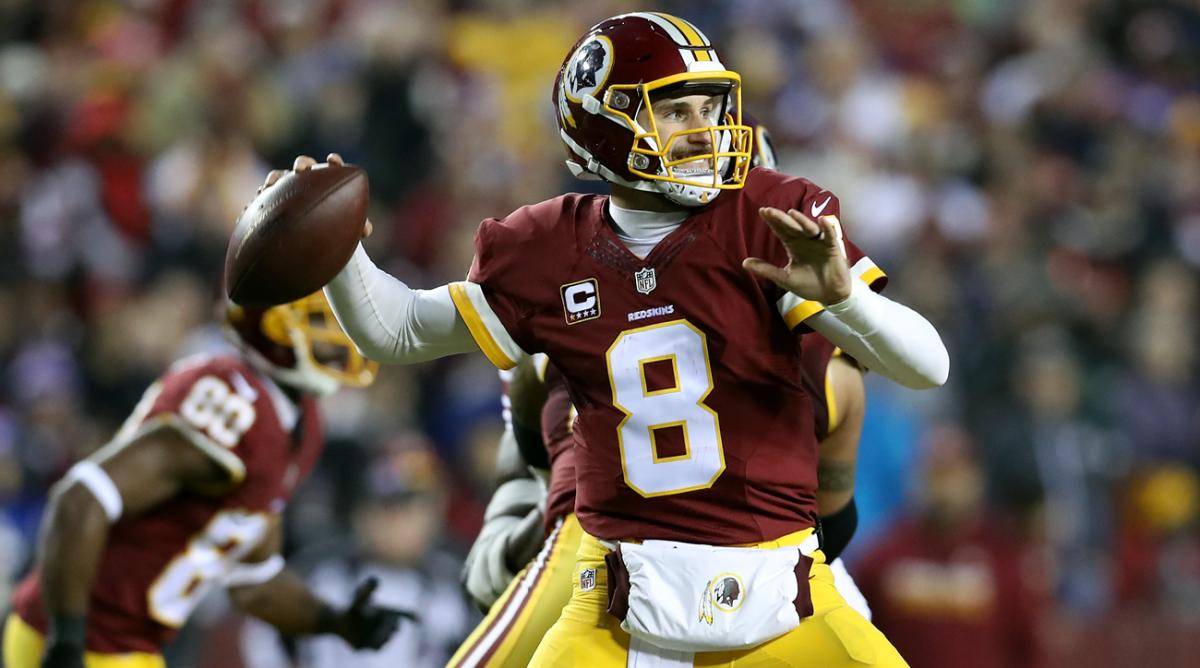Kirk Cousins Has All the Leverage Now

Kirk Cousins was there to see the franchise quarterback sitting courtside with the Redskins’ team owner at a Wizards game. He was there when Washington flipped its scheme upside down to accommodate that franchise QB. He was there when that franchise quarterback’s return from knee surgery took an offseason hostage, and when the team fired a coach for clashing with that franchise quarterback.
He was also there when that franchise quarterback was failing, and given another lifeline with his fifth-year option exercised, and then kept on the payroll as he lost his job to prop up the owner’s hope that his fading run in D.C. could be resuscitated. Cousins knows how a franchise quarterback is treated in Washington, because he was in Robert Griffin III’s draft class, taken two days and 100 picks after RG3 and given a front-row seat to witness all of that has unfolded.
• THE MMQB: Introducing Our All-Time Draft
And finally, this offseason, Cousins has started to feel like he’s That Guy. And, yes, it may seem weird to point such a thing out on the day that the deadline passed for Cousins to do a long-term deal and marry his football future to the Redskins, which means this saga is now assured to stretch into a fourth calendar year. But the truth is that Cousins has a chance to turn the tables on his employer and do to them what they did to him last year.
Last summer, I was talking to Cousins about his situation and how the Redskins were protecting themselves against the chance that his eight-game flourish to finish the 2015 season was just some comet crossing the sky. He pointed out that he was in a similar position in both high school in college, and said, “Here I am again. The team says they want to see another year. That’s fine.”

Today, Cousins is, in essence, saying the same thing to the Redskins. This offseason has been great for him. His relationships with teammates, his standing in the locker room, and where he’s at with his coaches—all of that has never been better, and even the contract negotiation is in a better place than it was before. So if you’re Cousins, and all this works out in Washington, then fantastic. If it doesn’t, you know one of your old coordinators, 49ers coach Kyle Shanahan, will be looking for a quarterback in 2018; and it’s not inconceivable that another, Rams coach Sean McVay, could also be in the market for an upgrade by then.
As for the financial end of this, waiting always made sense for Cousins. For him to do a long-term deal with Washington, he’d have to walk away from three attractive conclusions:
• A third straight franchise tag, which would give him $58.42 million between 2017 and ’18, and free agency at age 30 in ’19.
• A transition tag next year, which would set his floor at $52.68 million for ’17 and ’18, and give him a chance to test the market next March (with the Redskins retaining matching rights) at age 29.
• $23.94 million this year and free agency next year.
Those are tough for the Redskins to beat, and the de facto cost to the team for having not locked him down much sooner. Could this circumstance have been avoided? Of course. But that, and the story of how we got here, goes back to whether or not Cousins is a franchise quarterback.
The Redskins first approached Cousins’s reps about a deal in December 2015 (before a road game against the Bears) and were told that he wanted to play the year out before negotiating. The Skins were 5-7, but won four straight to make the playoffs.
• STEPHANIE APSTEIN: Elway and Marino Could Have Been Baseball Royalty
After that, the first offer came: $12.5 million per year, more than $7 million less than the franchise tag for 2016—at a time when 18 quarterbacks were making more than $16 million per. The team went to $15 million per before the combine, and $16 million per after it. But then Brock Osweiler signed for $18 million per year, and talks quieted and Cousins wound up playing out the season on the tag.
That set the stage for this year, with the Redskins’ initial offer of $100 million over five years (with $40 million guaranteed), carrying an average well short of the tag number that Cousins had in front of him. For a few months, that sat on the table. And then, after the draft, the Redskins moved, making a strong offer north of that previous one that, as I understand it, could have sparked a deal in 2016.
The issue?
Cousins’s leverage (see: those three options above) has strengthened considerably since. Also, Cousins’s 2017 money is secure already, and his financial prospects for 2018, absent a long-term deal, are great. So if the team wasn’t going to tie itself to Cousins in that way for 2019— which would cement his place in D.C.—it was going to be hard for the Redskins to find a solution that would make sense for him.
Last year, paying Cousins like a franchise quarterback would’ve gotten a deal done. This year, a deal might have gotten done had the team made a similar deal with full guarantees into Year 3. Instead, to paraphrase Cousins’ words from last August, here we are again. It’s a rare situation, with a multi-year starting quarterback and his team taking their relationship on a year-to-year basis.
The difference now? This time, Cousins gets to make the Redskins wait while he makes sure of it.
Question? Comment? Story idea? Let us know at talkback@themmqb.com
